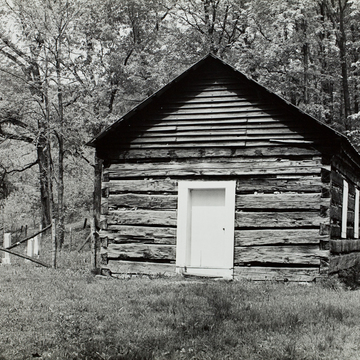This rugged survivor of a now vanished way of life, surrounded by a graveyard in a clearing of an isolated, forested hillside, embodies the popular, romantic image of West Virginia. The small, single-crib log church, measuring only 15 feet by 25 feet, stands eight logs tall. The logs, marked by the broadaxes that hewed and shaped them, are joined at the corners with deep and beautifully executed half-dovetail notches. Small stones and short laths covered with clay nogging compose the chinking. Gable ends are clapboarded, and a standing-seam metal roof now replaces the original wooden shingles. Inside, kerosene lamps and a potbellied stove complete the picture.
The church was named for justice of the peace Aaron S. Ruble, who witnessed the 1854 deed to the property. The deed specified that the church was to be free to all congregations except those of “Northern Principles,” an indication of growing doctrinal differences in the decade before the Civil War. The church was repaired several times during the twentieth century.




















